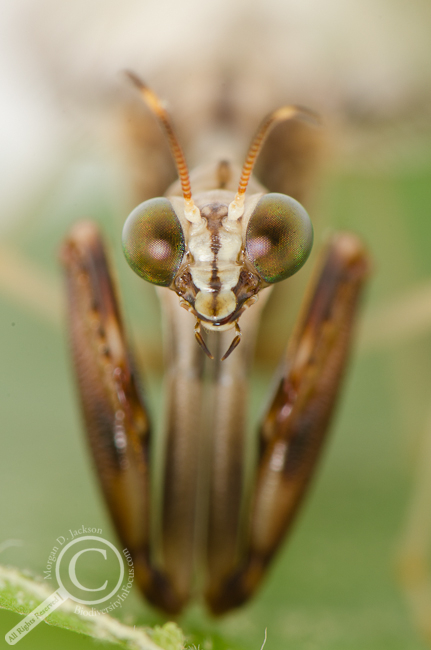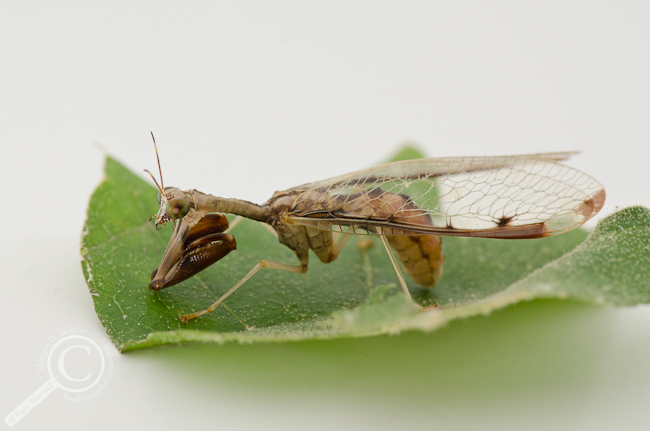Exciting news since the last Weekly Flypaper: Piotr Naskrecki, orthopteroid taxonomist, photographer, and author (Relics and The Smaller Majority) has started a new blog — The Smaller Majority. So far Piotr has been killing this whole blogging business, with fascinating posts on tropical entomology and macrophotography tips. I’m pretty sure I bookmarked every post he made for future reference, but here are a few of my favourites:
Now onto the rest of the best from the last 2 weeks!
General Entomology
If you ever need a gift idea for the Dragonfly Woman, she’s got a nice wishlist of field guides that any nature nut would appreciate.
Speaking of gifts, we’re right in the midst of wedding season, and if you need nuptial gift ideas, why not take a page out of the insect world.
Erica McAlister, the Diptera curator at the Natural History Museum, London, takes you on a backstage tour of the NHM insect collection and shows off some spectacular specimens, including a grasshopper hugging a mouse. Seriously.
What’s the biggest bug? The North Carolina State University Insect Collection has a couple of options to answer that.
Entomology is a hobby all unto its own for some people, but it also happens to be a sub-hobby for some fly fisherman!
My wife and I had a date night this week and went to see The Amazing Spider-Man. I really enjoyed it, but was a little disappointed that Peter Parker didn’t snack on a fly or two at some point in the movie. Even if you’re not an arachnid-infused superhero, there’s no reason why you shouldn’t consider eating bugs as Doug Yanega explains to the University of California Food Blog. The Weird Bug Lady even has a tasty sounding recipe for entomological power bars to get you started!
Flies – Diptera
Apparently I missed the memo about Photo Bombing blogs, as Matt Bergeron, Dave Stone and Alex Wild all showed off gorgeous photos of bombyliid bee flies.
Brian Brown is having a pretty good month for publications, with his latest discussing phorid flies which are parasites of endangered ants.
Researchers have bred “super” smart fruit flies which can count. I for one, welcome our new Dipteran overlords.
Black flies take the majority of bad press for Northern pests, but don’t forget to watch out for moose flies while in Alaska.
Robber flies are popular with a lot of people, including devoted beetler Ted MacRae. And with their own special facial hair, the mystax, it’s no wonder.
The Geek demonstrates that sometimes when you’re photographing flies, you’re only able to snipe one photo before they take off.
Beetles – Coleoptera
Emerald Ash Borer (Agrilus planipennis) has continued it’s inevitable march across eastern North America, this week being detected in Connecticut for the first time. What’s important about this is that Cerceris fumipennis, a solitary wasp which specializes on buprestid jewel beetles, was the first to detect it’s presence in the state. This is the sort of Bio-surveillance that Phil Careless and the rest of Team Cerceris had hoped for, and now hopefully more government agencies will invest in expanding this simple monitoring tool.
Cerceris fumipennis is also a useful tool for collecting other jewel beetles besides EAB as Ted MacRae recently found out.
Of course you don’t need to always rely on other species to find your jewel beetles for you, as the Geek reminds us to always look.
Some people can be picky eaters, but the same holds true for dung beetles, with species preferring different types of brown sauce, and Bug Girl is on it.
Why might it matter what type of dung a beetle prefers? Because places like Australia and New Zealand don’t have any native dung beetles, making agricultural waste a significant problem. Becky Crew has a nice feature on the work being done to bring dung beetles to New Zealand.
Not all scarab beetles like to feed on dung though, like these Green June Beetles that Derek Hennen found in his yard.
With summer comes the opportunity to watch fireflies flashing in the night. Check out this nice flash guide to see if you can recognize any of the species in your backyard, and contribute to a citizen science program.
Ants, Bees & Wasps – Hymenoptera
This photo of a flying bumblebee by Adrian Thysse might be the best of it’s kind that I’ve ever seen.
The Gratton Lab at the University of Wisconsin – Madison is working on an automated bee identification project.
Urban beekeepers in Edmonton are pushing for changes to bylaws that keep their hives in hiding.
Meanwhile in Edmonton, Matthias Buck has discovered 2 new species of paper wasps right under our noses.
The School of Ants is holding a student essay contest with a nice cash prize.
Eric Eaton shows that solitary wasps can be used for monitoring other insects, like stink bugs (potentially including the mega-pest Brown Marmorated Stink Bug) or membracids.
Moths & Butterflies – Lepidoptera
National Moth Week is coming up this week, so expect most of the bug-blogosphere to get a little scaley!
The Dragonfly Woman started a little earlier by announcing an event she’s helping with at her new job.
Other Insect Orders
Troy Bartlett thinks ants mite do a better job of taking care of their herds of membracids.
Ever wondered why your car attracts some insects like dragonflies and horse flies? The Dragonfly Woman has a great explanation.
It looks like the Cleveland Museum of Natural History is becoming ground zero for mantid research in North America.
The Neuroptera are an amazing group of insects with incredible diversity. Jonathan Wojcik provides a nice overview of that diversity, and introduced me to an amazing group called the Spoonwings (family Nemopteridae). Brian Cutting showed off a member of another one of my favourite groups, the Mantis flies, while Derek Hennen found a spectacular antlion adult.
Spiders – Arachnida
“Oh look at that lovely lady beetle! It looks so cute and cuddly and OH MY GOD!!!”
Next time I go to Chicago, I’m definitely rewarding the Chicago Hilton with my business for being so awesome with their natural history and outreach!
I hate when I get a spider web across my face while out walking in the woods, but I think I might have to learn more about spiders and their webbing from a book Bug Girl recently reviewed, Spider Silk by Leslie Brunetta and Catherine L. Craig.
Now if all spiders lived among the canopy of trees like this Hentzia mitrata that Chris Buddle and colleagues are studying, then I wouldn’t have to worry about silk wrapping my face…
Speaking of Chris, he went, he saw, he videoed; Beringian pseudoscorpions in the Yukon that is!
Taxonomy & Systematics
A parasitic isopod was recently described and named after Bob Marley. Too bad the authors messed up and published the name a few months earlier in an ecological paper before formally describing it. Everybody repeat after me — in taxonomy, the order in which you publish or publicize MATTERS.
Of course, because this species was named after somebody famous, the media took off with it and the BBC published a top 10 list of what I’m now going to start calling “Celebronyms”. Have I mentioned how much I hate these top 10 species lists lately? Because I do. With a passion. Ugh.
Where should money be invested to solve the taxonomic impediment? Quentin Wheeler of Arizona State University thinks technology leads the way (i.e. the University of Arizona’s new funding to revitalize and digitize their collection), while Bob Mesibov of the Queen Victoria Museum (Tasmania) argues that more taxonomists need to be hired first. Me? I think technology will be useless if there’s no one around to develop, maintain and actually use it. I’ll also need a job in 3-5 years, so I might be a bit biased here.
The Willi Hennig Society Meeting was held at the end of June, and Itsy Bitsy attended. So did Salva at Computer Cladistics, who has a fantastic detailed review of the conference.
Kevin Peterson is literally uprooting the mammal phylogeny with a new technique he’s developed. My question is what makes this new technique more accurate to the true evolutionary history of the mammals? Micro-RNA is also being used to study Diptera evolution, but I can’t understand why it’s considered more “accurate”. It’s a wonder I get any sleep at all with these types of questions rolling around in my head…
Does the way that we traditionally draw and think of phylogenies (i.e. a “tree” of life) block us from considering new ideas on relationships?
Academia
My post on Citations, Social Media & Science gathered some attention last week, including that of the researcher who’s improperly cited blog started the whole discussion. The author of the paper also stopped by and explained they tried to include the citation, but the publisher wouldn’t allow a blog to be cited like a journal. I’m not really sure why a publisher has so much control over the content of a journal rather than the editorial staff of said journal, but I find it troubling.
This is pretty handy for people just starting out in academia/grad school – Field Guide to Scientific Conferences: An Ecological Review.
Also handy, this complete walkthrough by Steve Hamblin on laying out and developing a poster for a conference. Many, many good tips here for balancing form and function. It’s also a pretty interesting view inside the head of a Post-Doc…
It’s good to remember that it matters how you write in academia, not just what you write.
Science Communication & Social Media
Bora Zivkovic (aka the Blogfather) drops a massive backgrounder on the history and rise of science blogging.
I’ve seen a bunch of people start blogs only to watch them peter out after a few weeks/months. As a blogger who has a relatively small (yet loyal) readership, I can sympathize with this post on Why Blogs Fail.
Here’s 10 Apps That Put Science In Your Pocket.
Dr. Olin Sander compares Twitter popularity during the recent Evolution meeting in Ottawa to a sage grouse lek. Awesome.
Photography
Ted MacRae demonstrates why the placement of your lighting sources and choice of background can have a dramatic effect on a photo’s feel.
Alex Wild has a nice flowchart of his digital darkroom workflow.
Adrian Thysse has a lovely interview with renowned nature photographer Heather Angel.
Other Fun Stuff
David Winter does a great job of explaining why red heads are here to stay. Looks like my wife won’t be getting rid of me that easily!
This fish grows ant-shaped appendages to get laid. I feel like there’s an inappropriate joke in here somewhere…
Who needs cable TV when you can get all kinds of drama & comedy from social media?
Aquaman makes a terrible marine mammal. He also makes a terrible superhero.
What would happen if a pitcher threw a baseball at 90% of the speed of light? I suspect he’d be investigated for Perfomance Enhancing Drug use and never make it into the Hall of Fame.
Video of the Week
Carl Zimmer was a plenary speaker at the annual meeting of the Society for the Presevation of Natural History Collections a few weeks ago, and they just posted his talk on YouTube. It’s long (more than an hour), but it’s an interesting talk and well delivered.
Further Reading
Bora Zivkovic – The Science Blogging Weekly, July 13th 2012 – (I made the Top 10 posts list! W00T!)
Ed Yong – Missing Links, July 14, 2012
Ed Yong – Missing Links, July 21, 2012



